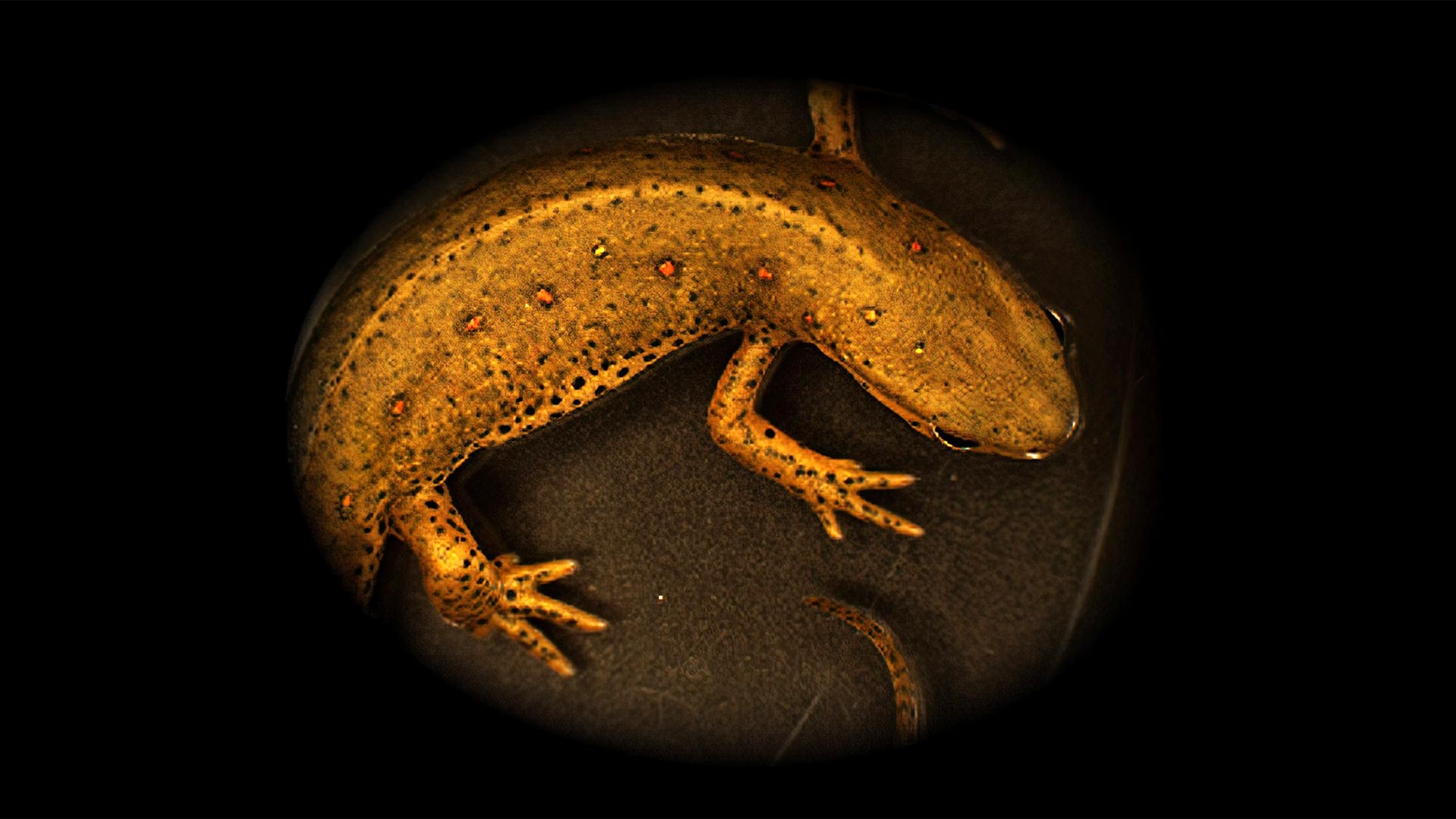

Yoon’un grubu tarafından incelenen semender türleri: Kırmızı benekli semender Notoftalmus viridescens. Olağanüstü rejeneratif yeteneklere sahip olan semenderleri inceleyen araştırmacılar, yaşlanan hücrelerin varlığının uzuv rejenerasyon sürecini hızlandırdığını keşfettiler. Hücreler, olgun kas liflerinin yenilenmeyi destekleyen eski kas hücrelerine dönüşmesi için sinyal veren faktörler salgılar. Bu bulgu, araştırmacıların insanların neden sınırlı rejenerasyon yeteneklerine sahip olduğunu anlamalarına ve muhtemelen yaşa bağlı hastalıklar için yeni tedaviler geliştirmelerine yardımcı olabilir. Kredi bilgileri: Maximina Yun
Bilim adamları, sözde yaşlanmış hücrelerin, yani bölünmeyi kalıcı olarak durduran hücrelerin, semenderlerde kaybolan uzuvların yenilenmesini desteklemek için yeni kas hücrelerinin üretimini desteklediğini göstermiştir.
Yaşlanma ve hastalıkla ilişkili yaşlanan hücreler rejeneratif özelliklere sahip olabilir. Semenderleri inceleyen araştırmacılar, yaşlanan hücrelerin, kas liflerinin farklılaşmaması için sinyal göndererek uzuv rejenerasyonunu hızlandırdığını ve bunun da yaşa bağlı hastalıklar için yeni tedavilere yol açabileceğini buldular.
Yaşlanmış hücreler, hücresel strese yanıt olarak bölünmeyi kalıcı olarak durdurmuş ancak ölmemiş hücrelerdir. Organizmalar yaşlandıkça, vücuttaki yaşlanan hücrelerin sayısı artar. Bu birikme şu anda yaşlanmanın bir özelliği olarak kabul ediliyor ve kanser de dahil olmak üzere çeşitli hastalıklarla bağlantılı. Bununla birlikte, bu hücrelerin gerçek doğası daha karmaşık ve içeriğe bağlı olabilir.
Artan sayıda kanıt, yaşlanan hücrelerin yaraları iyileştirme veya doku yaralanmasını önleme gibi yararlı etkileri olabileceğini düşündürmektedir. “Birkaç yıl önce grubumuz, yaşlanmış hücrelerin semender uzuv yenilenmesinin kilit aşamalarında bulunduğunu keşfetti. İlginç bir şekilde, diğer gruplar daha sonra bu hücreleri memeliler de dahil olmak üzere diğer yenilenme bağlamlarında buldular. Bu nedenle, bu hücrelerin katkıda bulunup bulunmadığını görmek istedik. Dresden Rejeneratif Tedaviler Merkezi’nde (CRTD) araştırma grubu lideri ve TU Dresden ve Max Planck Enstitüsü’nde Mükemmellik Fiziği (PoL) grubu lideri Dr.[{” attribute=””>Molecular Cell Biology and Genetics (MPI-CBG).
Senescent Cells Promote Regeneration
The researchers in Yun’s group study salamanders. These animals have unique regeneration abilities and are able to re-grow many organs of their bodies, including lost limbs. “Salamander limb regeneration is a fascinating process. In a matter of weeks, they re-grow a fully functional limb,” explains Dr. Yun.
To check if the presence of senescent cells influences the limb regeneration process, researchers in the Yun group found a way to modulate the number of senescent cells in the wound. The team observed that the presence of senescent cells enhanced the regeneration process.
“When more senescent cells were present in the wound, the animals developed a larger regeneration bud, or – as we call it – blastema. This is a collection of cells that are going to form all the needed tissues in the new limb. The larger the blastema, the more cells are there to regrow the limb and the quicker the regeneration process. The presence of senescent cells seemed to ‘fuel’ the regeneration process,” Dr. Yun says.
“Zombie” Signaling Promotes New Muscle Cells
Looking more closely at the blastema with and without the influence of the senescent cells, the Yun team uncovered a new mechanism that enhances the regeneration process and found that the presence of senescent cells increased the number of regenerating muscle cells. They showed that senescent cells secrete factors that stimulate nearby muscle tissue to take a developmental step back and produce new muscle.
“Our results show that senescent cells use cell-cell communication to influence the regeneration process. They secrete molecules that signal to mature muscle fibers to dedifferentiate into muscle progenitor cells. These cells can multiply themselves as well as differentiate into new muscle cells, thereby enhancing the regeneration process. This signaling appears to be an important part of promoting regeneration,” says Dr. Yun.
For now, the group focused on muscle, one of the most important tissues in the regenerating limb. However, the team is already investigating whether senescent cell signaling also contributes to the regeneration of other tissues.
Lessons From the Salamanders
Yun’s group is working with salamanders to study regeneration and aging processes. “Salamanders are one of the few animal species that seem to defy the natural aging process. They do not develop typical signs of aging and do not accumulate age-related diseases such as cancer. They also have extraordinary healing abilities,” says Dr. Yun. The animals can regenerate almost any organ in their body.
Studying salamanders is helping Dr. Yun and her colleagues at the CRTD understand the principles of the regeneration process and, in the long run, may help solve the puzzle of why humans have very limited regenerative abilities.
Reference: “Senescent cells enhance newt limb regeneration by promoting muscle dedifferentiation” by Hannah E. Walters, Konstantin E. Troyanovskiy, Alwin M. Graf and Maximina H. Yun, 6 April 2023, Aging Cell.
DOI: 10.1111/acel.13826

“Analist. Tutkulu zombi gurusu. Twitter uygulayıcısı. İnternet fanatiği. Dost pastırma hayranı.”





More Stories
Bilim insanları dünyadaki en büyük demir cevheri yataklarında milyar yıllık bir sırrı keşfetti
Fosillere göre tarih öncesi deniz ineği, timsah ve köpekbalığı tarafından yenildi
Büyük bir bindirme fayı üzerine yapılan yeni araştırma, bir sonraki büyük depremin yakın olabileceğini gösteriyor